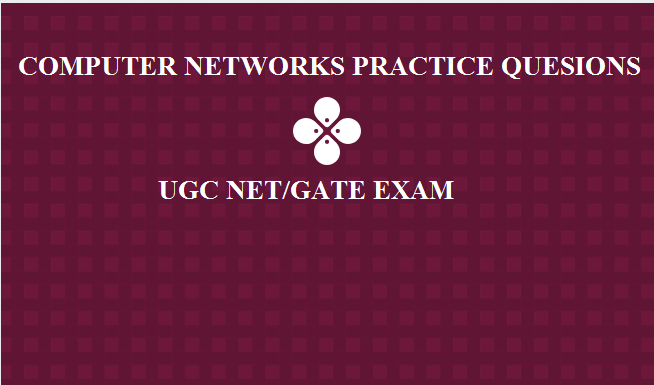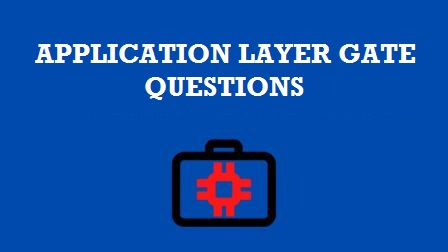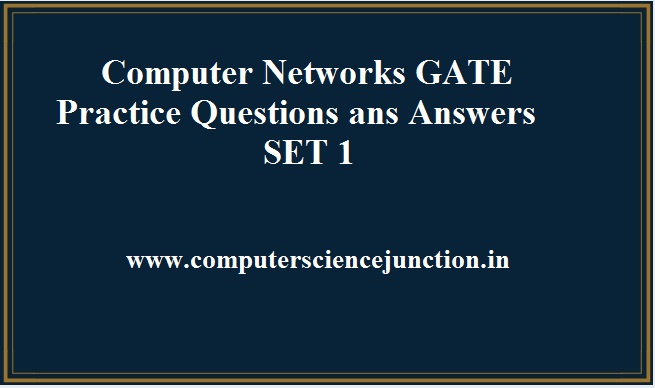Table of Contents
Computer Networks GATE Questions
Computer networks gate questions are discussed here in this tutorial. In this tutorial we have also explained the solutions of these computer networks gate questions.In this post different questions from computer networks subject for GATE and UGC NET exam are explained. These type of questions are generally asked in Gate and UGC NET exam.
Data for Questions 1 and 2 is given here –
Q1.If three IP networks A, B and C. Host HA in network A send messages. Message has 180 bytes of application data to a host HC in network C. The TCP layer add a 20 byte header to this message. After that this passes through an intermediate network B. The maximum packet size, including 20 byte IP header, in each network is
A :1000 bytes
B :100 bytes
C :1000 bytes
The network A and B are connected through a 1 Mbps link, while B and C are connected by a 512 Kbps link (bps=bits per second).
Question. 2.Assuming that the packets are correctly delivered, how many bytes,including headers, are delivered to the IP layer at the destination for one application message, in the best case ? Consider only data packets.
(A) 200 (B) 220
(C) 240 (D) 260
Question.2 .What is the rate at which application data is transferred to host Hc ? Ignore errors, acknowledgements, and other overheads.
(A) 325.5 Kbps (B) 354.5 Kbps
(C) 409.6 Kbps (D) 512.0 Kpps
Question.3 .Packets of the same session may be routed through different paths in
(A) TCP, but not UDP (B) TCP and UDP
(C) UDP but not TCP (D) Neither TCP, nor UDP
Question.4.The address resolution protoc0l (ARP) is used for
(A) Finding the IP address from the DNS
(B) Finding the IP address of the default gateway
(C) Finding the IP address that corresponds to a MAC address
(D) Finding the MAC address that corresponds to an IP address
Question.5.The maximum window size for data transmission using the selective reject protocol with n-bit frame sequence numbers is
(A) 2n (B) 2n-1
(C) 2 1 n – (D) 2n-2
Question 6.In a network of LANs connected by bridges, packets are set from one LAN to another through intermediate bridges. Since more than one path may exist between two LANs, packets may have to be routed through multiple bridges. Why is the spanning tree algorithm used for bridge-routing ?
(A) For shortest path routing between LANs
(B) For avoiding loops in the routing paths
(C) For fault tolerance
(D) For minimizing collisions
Question. 7.An organization has a class B network and wishes to form subnets for 64 departments. The subnet mask would be
(A) 255.255.0.0 (B) 255.255.64.0
(C) 255.255.128.0 (D) 255.255.255.0
Question. 8.In a packet switching network, packets are routed from source to destination along a single path having two intermediate node. If the message size is 24 bytes and each packet contains a header of 3 bytes, then the optimum packet size is
(A) 4 (B) 6
(C) 7 (D) 9
Question.9.Suppose the round trip propagation delay for a 10 Mbps Ethernet having 48-bit jamming signal is 46.4 µs . The minimum frame size is
(A) 94 (B) 416
(C) 464 (D) 512
Question. 10.For which one of the following reason: does Internet Protocol (IP) use the time-to-live (TTL) field in the IP datagram header?
(A) Ensure packets reach destination within that time
(B) Discard packets that reach later than that time
(C) Prevent packets from looping indefinitely
(D) Limit the time for which a packet gets queued in intermediate routers
Conclusion and Summary
In this tutorial we have discussed and explained some computer networks gate questions asked in previous year.
Please provide your feedback or leave comment so that we can improve and provide you a good quality tutorials.
If you find this page useful then please Like and Share the post on Facebook, Twitter, LinkedIn through their icons as given below.
Don’t stop learning and practice.
All The Best






